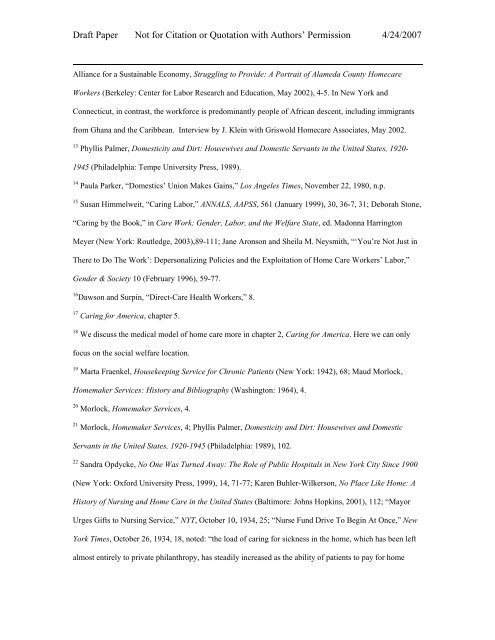Organizing Home Care: - School of Social Service Administration
Organizing Home Care: - School of Social Service Administration
Organizing Home Care: - School of Social Service Administration
You also want an ePaper? Increase the reach of your titles
YUMPU automatically turns print PDFs into web optimized ePapers that Google loves.
Draft Paper Not for Citation or Quotation with Authors’ Permission 4/24/2007<br />
Alliance for a Sustainable Economy, Struggling to Provide: A Portrait <strong>of</strong> Alameda County <strong>Home</strong>care<br />
Workers (Berkeley: Center for Labor Research and Education, May 2002), 4-5. In New York and<br />
Connecticut, in contrast, the workforce is predominantly people <strong>of</strong> African descent, including immigrants<br />
from Ghana and the Caribbean. Interview by J. Klein with Griswold <strong>Home</strong>care Associates, May 2002.<br />
13 Phyllis Palmer, Domesticity and Dirt: Housewives and Domestic Servants in the United States, 1920-<br />
1945 (Philadelphia: Tempe University Press, 1989).<br />
14 Paula Parker, “Domestics’ Union Makes Gains,” Los Angeles Times, November 22, 1980, n.p.<br />
15 Susan Himmelweit, “Caring Labor,” ANNALS, AAPSS, 561 (January 1999), 30, 36-7, 31; Deborah Stone,<br />
“Caring by the Book,” in <strong>Care</strong> Work: Gender, Labor, and the Welfare State, ed. Madonna Harrington<br />
Meyer (New York: Routledge, 2003),89-111; Jane Aronson and Sheila M. Neysmith, “‘You’re Not Just in<br />
There to Do The Work’: Depersonalizing Policies and the Exploitation <strong>of</strong> <strong>Home</strong> <strong>Care</strong> Workers’ Labor,”<br />
Gender & Society 10 (February 1996), 59-77.<br />
16 Dawson and Surpin, “Direct-<strong>Care</strong> Health Workers,” 8.<br />
17 Caring for America, chapter 5.<br />
18 We discuss the medical model <strong>of</strong> home care more in chapter 2, Caring for America. Here we can only<br />
focus on the social welfare location.<br />
19 Marta Fraenkel, Housekeeping <strong>Service</strong> for Chronic Patients (New York: 1942), 68; Maud Morlock,<br />
<strong>Home</strong>maker <strong>Service</strong>s: History and Bibliography (Washington: 1964), 4.<br />
20 Morlock, <strong>Home</strong>maker <strong>Service</strong>s, 4.<br />
21 Morlock, <strong>Home</strong>maker <strong>Service</strong>s, 4; Phyllis Palmer, Domesticity and Dirt: Housewives and Domestic<br />
Servants in the United States, 1920-1945 (Philadelphia: 1989), 102.<br />
22 Sandra Opdycke, No One Was Turned Away: The Role <strong>of</strong> Public Hospitals in New York City Since 1900<br />
(New York: Oxford University Press, 1999), 14, 71-77; Karen Buhler-Wilkerson, No Place Like <strong>Home</strong>: A<br />
History <strong>of</strong> Nursing and <strong>Home</strong> <strong>Care</strong> in the United States (Baltimore: Johns Hopkins, 2001), 112; “Mayor<br />
Urges Gifts to Nursing <strong>Service</strong>,” NYT, October 10, 1934, 25; “Nurse Fund Drive To Begin At Once,” New<br />
York Times, October 26, 1934, 18, noted: “the load <strong>of</strong> caring for sickness in the home, which has been left<br />
almost entirely to private philanthropy, has steadily increased as the ability <strong>of</strong> patients to pay for home
















